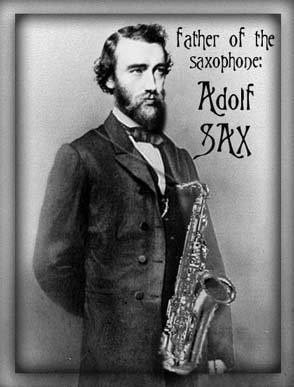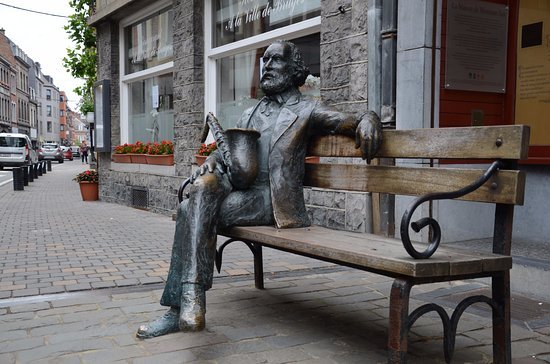



Antoine-Joseph Sax was born on 6 November 1814, in Dinant, in what is now Belgium, to Charles-Joseph Sax and his wife Marie-Joseph (Masson). While his given name was Antoine-Joseph, he was referred to as Adolphe from childhood. His father and mother were instrument designers themselves, who made several changes to the design of the French horn. Adolphe began to make his own instruments at an early age, entering two of his flutes and a clarinet into a competition at the age of 15. He subsequently studied performance on those two instruments as well as voice at the Royal Conservatory of Brussels.
Sax faced many brushes with death. As a child he once fell from a height of three floors, hit his head on a stone and was believed dead. At the age of three, he drank a bowl full of acidic water mistaking it for milk, and later swallowed a pin. He received serious burns from a gunpowder explosion, and once fell onto a hot cast-iron frying pan, burning his side. Several times he avoided accidental poisoning and asphyxiation from sleeping in a room where varnished furniture was drying. Another time young Sax was struck on the head by a cobblestone and fell into a river, almost dying.
His mother once said that "he's a child condemned to misfortune; he won't live." His neighbors called him "little Sax, the ghost".
Career and later life
After leaving the Royal Conservatory of Brussels, Sax began to experiment with new instrument designs, while his parents continued their business of making conventional instruments. Sax's first important invention was an improvement in bass clarinet design which he patented at the age of 24. He relocated permanently to Paris in 1842 and began working on a new set of valved bugles. While he did not invent this instrument, his examples were much more successful than those of his rivals and became known as saxhorns. Hector Berlioz was so enamoured of these that he arranged in February 1844 for one of his pieces to be played entirely on saxhorns. They were made in seven different sizes and paved the way for the creation of the flugelhorn. Today, saxhorns are sometimes used in concert bands, marching bands, and orchestras. The saxhorn also laid the groundwork for the modern euphonium.
Sax also developed the saxotromba family, valved brass instruments with narrower bore than the saxhorns, in 1845, though they survived only briefly.
The use of saxhorns spread rapidly. The saxhorn valves were accepted as state-of-the-art in their time and remain largely unchanged today. The advances made by Adolphe Sax were soon followed by the British brass band movement which exclusively adopted the saxhorn family of instruments. The Jedforest Instrumental Band formed in 1854 and The Hawick Saxhorn Band formed in 1855, within the Scottish Borders, a decade after saxhorn models became available.
The period around 1840 saw Sax inventing the clarinette-bourdon, an early unsuccessful design of contrabass clarinet. On 28 June 1846 he patented the saxophone, intended for use in orchestras and military bands. By 1846 Sax had designed saxophones ranging from sopranino to subcontrabass although not all were built. Composer Hector Berlioz wrote approvingly of the new instrument in 1842 but despite his support saxophones did not become a standard part of the orchestra. Their ability to play technical passages easily like woodwinds yet project loudly like brass instruments led to their inclusion in military bands in France and elsewhere. His reputation helped secure him a job teaching at the Paris Conservatory in 1857.
Sax continued to make instruments later in life and presided over the new saxophone program at the Paris Conservatory. Rival instrument makers both attacked the legitimacy of his patents and were sued by Sax for patent infringement. These legal troubles continued for over 20 years. He was driven into bankruptcy three times: in 1852, 1873, and 1877.
Sax suffered from lip cancer between 1853 and 1858 but made a full recovery. In 1894 he died in poverty in Paris and was interred in section 5 (Avenue de Montebello) at the Cimetière de Montmartre in Paris.

The saxophone (referred to colloquially as the sax) is a family of woodwind instruments usually made of brass and played with a single-reed mouthpiece.
Although most saxophones are made from brass, they are categorized as woodwind instruments because sound is produced by an oscillating reed (traditionally made out of woody cane) rather than lips vibrating in a mouthpiece cup as with the brass instrument family. As with the other woodwind instruments, the pitch of the note being played is controlled by covering holes in the body tube to control the resonant frequency of the air column by changing the effective length of the tube. The player covers or uncovers the holes by pressing keys.
The saxophone is used in wide range of musical styles including classical music (such as concert bands, chamber music, solo repertoire, and, occasionally, orchestras), military bands, marching bands, jazz (such as big bands and jazz combos), and contemporary music. The saxophone is also used as a solo and melody instrument or as a member of a horn section in some styles of rock and roll and popular music. Saxophone players are called saxophonists.
The saxophone was invented by the Belgian instrument maker Adolphe Sax in the early 1840s,[4] and saxophones have since been produced in a variety of models distinguished by transpositions within instrument sets and tuning standard. Adolphe Sax patented the saxophone on 28 June 1846, in two groups of seven instruments each. Each series consisted of instruments ranked by pitch, in alternating transposition. The series pitched in B♭ and E♭ soon became dominant and most saxophones encountered today are from this series. Instruments from the series pitched in C and F never gained a foothold and constituted only a small percentage of instruments made by Sax. High Pitch (also marked "H" or "HP") saxophones tuned sharper than the (concert) A = 440 Hz standard were produced into the early twentieth century for sonic qualities suited for outdoor uses, but are not playable to modern tuning and are considered obsolete. Low Pitch (also marked "L" or "LP") saxophones are equivalent in tuning to modern instruments. C soprano and C melody saxophones were produced for the casual market as parlor instruments during the early twentieth century. Saxophones in F were introduced during the late 1920s but never gained acceptance. The modern saxophone family consists entirely of instruments in the B♭ – E♭ series, historical and experimental instruments notwithstanding. The saxophones with widest use and availability are the soprano, alto, tenor, and baritone saxophones.
Coincident with the more widespread availability of saxophones in the US around the turn of the century was the rise of ragtime music. The bands featuring the syncopated Latin- and African-American rhythmic influences of ragtime were an exciting new feature of the American cultural landscape and provided the groundwork for new styles of dancing. Two of the best known ragtime-playing brass bands with saxophones were those led by W. C. Handy and James R. Europe. Europe's 369th Infantry Regiment Band popularized ragtime in France during its 1918 tour. The rise of dance bands into the 1920s followed from the popularity of ragtime. The saxophone was also used in Vaudeville entertainment during the same period. Ragtime, Vaudeville, and dance bands introduced much of the American public to the saxophone. Rudy Wiedoeft became the best known individual saxophone stylist and virtuoso during this period leading into the "saxophone craze" of the 1920s. Following it, the saxophone became featured in music as diverse as the "sweet" music of Paul Whiteman and Guy Lombardo, jazz, swing, and large stage show bands.
The rise of the saxophone as a jazz instrument followed its widespread adoption in dance bands during the early 1920s. The Fletcher Henderson Orchestra, formed in 1923, featured arrangements to back up improvisation, bringing the first elements of jazz to the large dance band format.[32] Following the innovations of the Fletcher Henderson Orchestra, the Duke Ellington Orchestra and Jean Goldkette's Victor Recording Orchestra featured jazz solos with saxophones and other instruments. The association of dance bands with jazz would reach its peak with the swing music of the 1930s. The large show band format, influenced by the 1930s swing bands, would be used as backing for popular vocalists and stage shows in the post World War II era, and provided a foundation for big band jazz. Show bands with saxophone sections became a staple of television talk shows (such as the Tonight Show that featured bands led by Doc Severinsen and Branford Marsalis) and Las Vegas stage shows. The swing era fostered the later saxophone styles that permeated bebop and rhythm and blues in the early postwar era.

No comments:
Post a Comment